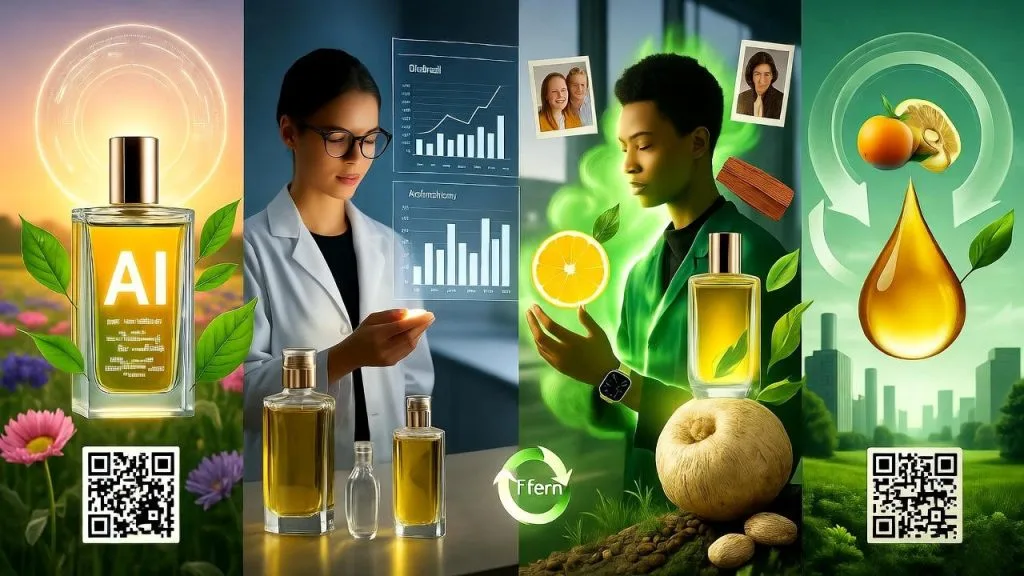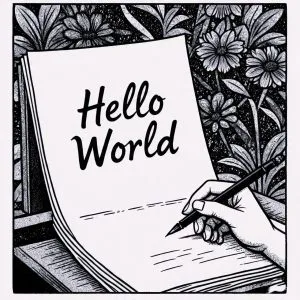The Dawn of a New Olfactory Era
In 2025, the fragrance industry stands at a fascinating crossroads where technology, sustainability, and individuality meet. No longer just a luxury accessory, perfumes have evolved into expressions of identity, mood, and values. As artificial intelligence (AI) and eco-conscious innovation shape the future, both established houses like Dior, Chanel, and Tom Ford, and rising names like Emeshel are redefining what it means to wear a scent.
The modern consumer isn’t just buying a fragrance—they’re buying a story, a belief, and often, a cause. This shift has transformed how brands create, package, and market their scents. Let’s explore how the triad of AI, sustainability, and personalization is fueling a smart revolution, one that is as radical as it is fragrant.

The “Smart Nose”: How AI is Unbottling Creativity
For centuries, the creation of perfume has been a cloistered art form, reliant on the extraordinary talent of human “noses” (perfumers) and their years of apprenticeship. In 2025, this tradition is not being replaced, but powerfully augmented. The rise of AI and sustainability in fragrance creation is not about removing the artist, but about giving them an infinitely more powerful brush.
From Perfumer’s Apprentice to Digital Maestro
Artificial intelligence, specifically machine learning, is now the ultimate co-pilot for the modern perfumer. Major fragrance houses like Givaudan, Firmenich, and IFF (International Flavors & Fragrances) have invested billions in proprietary AI platforms. These systems, like IFF’s “Science of Wellness” program, are not just mixing chemicals; they are processing and understanding data on an unprecedented scale.
Imagine an AI that has:
- Analyzed the chemical composition of every successful fragrance launched in the last 50 years.
- Cross-referenced this data with millions of real-time consumer reviews from around the world, using Natural Language Processing (NLP) to understand why people love a certain scent in Brazil versus Japan.
- Studied the neurological and emotional responses (neuro-perfumery) that specific molecules elicit, linking “sandalwood” to “calm” or “citrus” to “energy” with quantifiable data.
- Instantly calculated the sustainability score, biodegradability, and potential allergen profile of a million hypothetical formulas.
This is what the 2025 perfumer has at their fingertips. An AI can suggest novel pairings—a forgotten historical ingredient with a new biotech molecule—that a human might take a lifetime to discover. It can predict, “The market is fatigued with heavy Ouds; the next trend is a ‘salty floral’ with a top note of yuzu and a base of upcycled seaweed.” This accelerates innovation from years to weeks, allowing brands to be incredibly agile.
AI-Driven Personalization: The Scent of You
The biggest shift driven by AI is the move from mass-market luxury to hyper-personalization. The vague categories of “for him” or “for her” feel archaic in 2025. The new luxury is a scent that is uniquely, algorithmically yours.
This goes far beyond a simple online quiz. Today’s “smart fragrance” platforms, like those pioneered by startups such as EveryHuman, use AI to analyze a complex matrix of personal data:
- Biometric Data: Some systems link to your wearable tech (like an Apple Watch or Oura Ring) to gauge your stress levels, sleep patterns, and heart rate, suggesting scents to enhance your wellness.
- Olfactory Preferences: AI guides you through a “scent discovery” process, learning from your reactions to different notes to build a unique profile.
- Even DNA: Emerging tech explores how our unique genetic markers (specifically olfactory receptors) might predispose us to certain scent families.
The result? A bespoke formula, generated by AI and approved by a human perfumer, that is not just a perfume but a personal wellness tool. Tom Ford, long a master of creating scents that evoke a specific mood or “story” (like Fing Fabulous or Tobacco Vanille), built his brand on this concept of scent-as-identity. AI is the technological culmination of this philosophy, taking the “story” and making you the main character.
The AI and Sustainability Connection: The Unseen Synergy
Crucially, AI is also a primary driver for the second pillar: sustainability. This is where the AI and sustainability in fragrance narrative truly intertwines. How? By solving the industry’s most complex environmental challenges.
AI algorithms are now essential for:
- Green Chemistry: AI can predict the properties of molecules that don’t even exist yet. This allows scientists to design new, 100% biodegradable scent molecules from the ground up, replacing “forever chemicals” or ingredients that harm aquatic life.
- Sustainable Sourcing: AI models can predict crop yields for ingredients like vanilla in Madagascar or patchouli in Indonesia, helping brands avoid over-harvesting and ensuring fair prices for farmers.
- Finding Alternatives: When a natural ingredient is endangered (like Indian Sandalwood) or ethically problematic (like animal-derived musk), AI can sift through millions of combinations to create a “bio-identical” equivalent in a lab, protecting biodiversity.
AI is the “smart” in this smart revolution, optimizing supply chains to reduce carbon footprints and designing scents that are born sustainable, not just marketed as such.
The Green Revolution: Sustainability as the New Luxury
In 2025, sustainability is no longer a “nice to have” marketing buzzword. It is the core metric of luxury. Consumers, armed with more information than ever, are demanding radical transparency. They don’t just want to know what’s in the bottle; they want to know where it came from, who grew it, and what happens to the bottle when it’s empty.
The luxury houses have responded. Dior, under LVMH, has its “Beauty as a Legacy” program, a massive sustainability plan. Their goals are clear: by 2028, 100% of their packaging will be refillable, recyclable, or reusable, and they are aggressively moving to phase out virgin fossil plastics. This is the new standard.
Beyond the Bottle: The Packaging Renaissance
For decades, the weight of a perfume bottle—heavy glass, a metal cap, a cellophane-wrapped box—was synonymous with its value. In 2025, this is seen as “old luxury.” The new luxury is intelligent, minimal, and circular.
The most exciting innovation? Mycelium. This is the root structure of mushrooms, and it’s a game-changer. Brands like the indie darling Ffern (a perfect case study in new luxury) have adopted it.
- It’s “grown,” not manufactured, in 7 days (vs. 5-7 years for a tree for cardboard).
- It uses agricultural waste as its food source.
- It’s 100% home-compostable, breaking down in a garden in just 30-90 days.
- Its production can be carbon-negative.
Ffern went a step further: they eliminated the plastic cap entirely and ship their bottles in a custom-grown mycelium tray. They even include seeds for customers to use the tray as a planter. This is not just packaging; it’s a sustainable experience.
This is where brands like Emeshel, known for their stunning, art-piece glass bottles that are already collector’s items, have a unique position. Their philosophy has always been about the bottle as a permanent object of art, not a disposable container. This idea of “forever packaging” aligns perfectly with the 2025 circular economy, a concept they pioneered through art, which is now becoming a mainstream sustainability goal.
We are also seeing a massive push for refillable systems. Dior’s “Beauty as a Legacy” and initiatives from countless other brands are building “fragrance fountains” in stores and selling simple glass “refill” vials, decoupling the beautiful “parent” bottle from the “juice” itself.
Green Chemistry & The Rise of “Clean” Scents
The “clean” beauty movement has officially taken over fragrance. But in 2025, “clean” means more than just “natural.” We now understand that “natural” is not always sustainable. Over-harvesting endangered sandalwood is natural, but it’s not sustainable. Allergens from natural essential oils are still allergens.
The new “clean” is defined by two things: transparency and green chemistry.
- Transparency: Brands are finally ditching the “parfum” or “fragrance” catch-all on ingredient labels and disclosing their full formulas, or at least their full allergen lists.
- Green Chemistry: This is the science of creating safe, sustainable, high-performance molecules in a lab. Using biotechnology, scientists can now “bio-ferment” ingredients. They can take a single yeast cell, feed it sugarcane, and have it produce a perfect, 100% consistent rose or patchouli note without ever picking a flower or planting a field.
“We are moving from a model of extraction to a model of creation. Green chemistry allows us to create the most beautiful scents in the world with zero negative impact on the planet. This is the future of AI and sustainability in fragrance.”
Upcycling: Trash to Treasure
One of the most creative and impactful trends is upcycling. Fragrance houses are now looking at the waste streams from other industries as a source of raw materials.
- Citrus Peels: The juice industry throws away tons of citrus peels. These are now cold-pressed to extract valuable essential oils.
- Wood Waste: Sawdust and wood chips from the furniture industry are processed to extract cedar and pine notes.
- Used Rose Petals: After a rose has been distilled once for its “absolute,” the leftover “rose water” and petals are now being re-distilled using new techniques to capture a different, greener, fruitier facet of the scent.
Eurofragance recently unveiled “Olivante,” a new captive molecule derived from the waste of olive oil production, which has a surprisingly complex and luxurious leathery, oud-like scent. This is the circular economy in its most fragrant form.
Ethical Sourcing and Radical Transparency
For the ingredients that must be farmed—the irreplaceable jasmine from Grasse, the vetiver from Haiti—the focus has shifted to regenerative agriculture and radical transparency.
This is where a house like Chanel shines. Chanel has, for decades, famously protected its terroir in Grasse, France. They own and manage their own fields of jasmine and May rose, ensuring the highest quality for Chanel No. 5. This long-term thinking, once seen as just quality control, is now the model for sustainability. They are not just farmers; they are guardians of a specific ecosystem.
Dior is following suit with its regenerative gardens, cultivating flowers in a way that actively restores biodiversity and soil health, rather than just extracting from it.
AI and Sustainability in Fragrance
To prove it, brands are turning to technology. Blockchain is now being used to track a bottle of perfume all the way back to the specific farm—and even the farmer—that grew its ingredients. A consumer in 2025 can scan a QR code on a box and see the entire journey, verifying that the vanilla was fairly traded and the sandalwood was sustainably grown. This is the new, non-negotiable definition of luxury.

The Personalization Matrix: When AI, Sustainability, and Identity Collide
This brings us to the convergence of all three trends. The 2025 consumer doesn’t want to choose between personalization, sustainability, and technology. They expect all three, working in perfect harmony.
The “Mood-Scent” Connection
The “smart revolution” is also happening in our homes and on our bodies. We are moving beyond static perfume bottles and into a world of adaptive, personalized scent diffusion.
- Smart Diffusers: Devices that connect to your home AI or calendar. They can gently diffuse a “focus” scent (like rosemary and citrus) in your office when it sees a “Deep Work” block in your schedule, and automatically switch to a “calm” scent (like lavender and chamomile) an hour before your scheduled bedtime.
- Scent as Wellness: AI-powered apps use biometric feedback to create “scent playlists” for your mood, just like you have music playlists. Feeling stressed? The app suggests a scent proven to lower cortisol. Need to wake up? It suggests a stimulating, bright green scent.
This is the ultimate expression of AI and sustainability in fragrance: a system that knows you, adapts to you, and uses ingredients that are both emotionally effective and environmentally harmless. The fragrance is no longer a static “armor” you put on in the morning; it’s a dynamic, responsive companion.
Challenges on the Horizon: The Scent of Reality
This fragrant new world is not without its challenges. The cost of R&D for green chemistry and AI platforms is immense, creating a high barrier to entry. There is also the risk of consumer confusion. What really defines “clean” or “sustainable”? Without global, industry-wide standards, “greenwashing” remains a significant threat.
Furthermore, there is the question of privacy. How much personal data—from our DNA to our real-time stress levels—are we willing to give a brand in exchange for the “perfect” scent? The 2025 revolution is as much an ethical negotiation as it is a technological one.
And what of the “soul”? Can an AI-generated formula truly have the same “soul” as a creation born from a human perfumer’s lifetime of memories and emotions? The best brands of 2025 understand this. They use AI as the ‘what’ and the ‘how,’ but they rely on the human perfumer for the ‘why’—the story, the emotion, the magic. The machine finds the path, but the artist decides on the destination.
Conclusion: The Future Smells Smart, Green, and Uniquely You
The AI and sustainability in fragrance movement is not a fleeting trend; it is the new foundation of the industry. By 2025, we have moved past the idea of perfume as a simple commodity. It has become a complex, intelligent, and deeply personal product that sits at the intersection of biotechnology, data science, and environmental stewardship.
The “Smart Revolution” is here. It’s a revolution where the most established houses like Dior and Chanel are proving their legacy through regenerative sourcing, and where disruptors are using AI and mycelium to build the future from the ground up.
The modern consumer is no longer just a consumer; they are a co-creator, a curator, and a conscious citizen. They are buying a story, a belief, and a cause. And in 2025, that story smells smarter, greener, and more like them than ever before.






